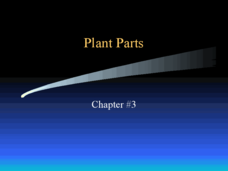Berkshire Museum
The Three Life-Giving Sisters: Plant Cultivation and Mohican Innovation
Children gain first-hand experience with Native American agriculture while investigating the life cycle of plants with this engaging experiment. Focusing on what the natives called the Three Sisters - corn, beans, and squash - young...
Terminix
The Pollinator
What do bees and children have in common? They both love their sweets. Decorate a flower pot or bucket to look like a brightly colored flower and fill it with wrapped candy and cheese puffs. Have learners reach into grab the candy,...
Baylor College
Plant Parts You Eat
Plants provide a variety of delicious foods essential for human survival. In the fourth lesson of this series on food science, young scientists investigate common fruits, vegetables, and grains in order to determine which plant part is...
Curated OER
Plants Scavenger Hunt Activity
The hunt is on! Provide young botanists with a list of eighteen plant-related questions and let them loose as they search for answers on corresponding fact cards. Perform this activity in the classroom or use it as an opportunity to take...
Curated OER
Plant Parts
Little ones identify the parts of a plant and practice following directions at the same time. They color each part of the flowering plant the color indicated on the sheet. Roots are brown, leaves are green, the flower is red, and the...
Curated OER
Retelling the Tiny Seed
Here is a very age appropriate idea that can be stretched, modified, or used as is. Learners review plant parts, discuss pollination, read the story The Tiny Seed, and write a retell sentence. Their sentences describe to way a seed...
Curated OER
Edible and Medicinal Plants: Field Trip Guide
Though it's designed to guide a field trip to the New York Botanical Garden, you could take resource like this one to a local park, wilderness area, school garden, or even a weedy empty lot. Middle schoolers identify plant parts and...
Curated OER
Six Plant Parts
Young scholars create a harvest burrito out of fruit, flowers, roots, stems, and more. In this plants lesson plan, students go out into the garden and identify the 6 plant parts.
Curated OER
Plants
One slide reviews the main plant parts and most of the remaining slides address seven plant processes of life. This is a different approach to introducing the life of a plant. Three tasks are assigned to viewers on the last slide, making...
Curated OER
Plant Life Cycle: Quiz Game
Play the game, Who Wants to be a Millionaire? to review plant parts, life cycle, and pollination. There are 10 questions that get kids thinking about seeds, seed dispersal, pollination, and plant parts. This game is has audio and looks...
Curated OER
Meet the Plants
Are you looking for a PowerPoint that identifies and explains the job each plant part performs? Perhaps you've found it! Examples of different types of plants, as well as common household items derived from plants are included. The text...
Curated OER
How Are Plants Similar And Different?
Studetns create an index card database of different categories of plants such as bushes, trees, flowers, grasses and vegetables. They review the different parts of a plant and label pictures of plants on the database cards. They use the...
Curated OER
Get to The Root of It!
Pupils study a real plant to explore its parts. They discover the function of the plant parts which they diagram and label.
Curated OER
Vegetation Scavenger Hunt
Students use picture cards to familiarize themselves with plant structures and characteristics. They collect plant specimens without destroying the plant and mount them creating a class herbarium.
Curated OER
Tic Tac Plant Parts
This plant biology PowerPoint introduces plant parts and their functions. This PowerPoint allows students to identify each plant part on a diagram, along with its' function. The slides contain a clear explanation of how each plant part...
Curated OER
Yummy Plant Parts
Middle schoolers examine plant parts. In this botany lesson, students examine various edible plants and how their adaptations help them to grow. They observe stems, leaves, roots and flowers of plants and discuss the relationship between...
Curated OER
Ho'opiha - Growing in Knowledge: Terrarium Project
Learners explore environmental protection by conducting a research experiment in class. In this botany lesson, students identify the necessities for growing a plant indoors and create a small terrarium for their plant. Learners observe...
Curated OER
Tops and Bottoms
First graders classify vegetables by which parts are edible. In this plant biology lesson, 1st graders are read Tops and Bottoms by Janet Stevens, participate in a discussion of which plant parts are edible in the story, then sort real...
Curated OER
How to: Build a Plant Cell
Students build a 3-dimensional model of a plant cell with household objects. In this plant biology lesson, students construct replica plant cells in groups of three. After completing their projects, students share their creations with...
Curated OER
Planting
Fifth graders study the parts of a plant and how they live and grow. In this plant growth lesson plan, 5th graders investigate the processes that plants go through to produce oxygen and release moisture. Diagrams, images, and background...
Curated OER
Eating Plants
Learners identify parts of a plant. For this life science lesson, student groups locate the leaves and fruits on vegetables, then find the roots. Lesson includes extension activities and background teacher information.
Curated OER
Parts of the Plants
Second graders discuss as a class what they know about plants viewing several pictures of plants as well as a tree poster. They work in groups to observe a flowering plant which is removed from a pot with the soil brushed away and is...
Curated OER
What Parts Are There to a Plant?
Students identify and sort plant parts through hands-on activities and group discussions and then work with magnifying lenses and tape measures to document their observations on a student sheet.
Curated OER
Plant Parts Chapter #3
A few diagrams and bullet-point notes fill the 24 slides of this presentation on plant parts. The content is advanced enough for high school or college botany courses. The diagrams, however, are of substandard quality and quantity. You...

























